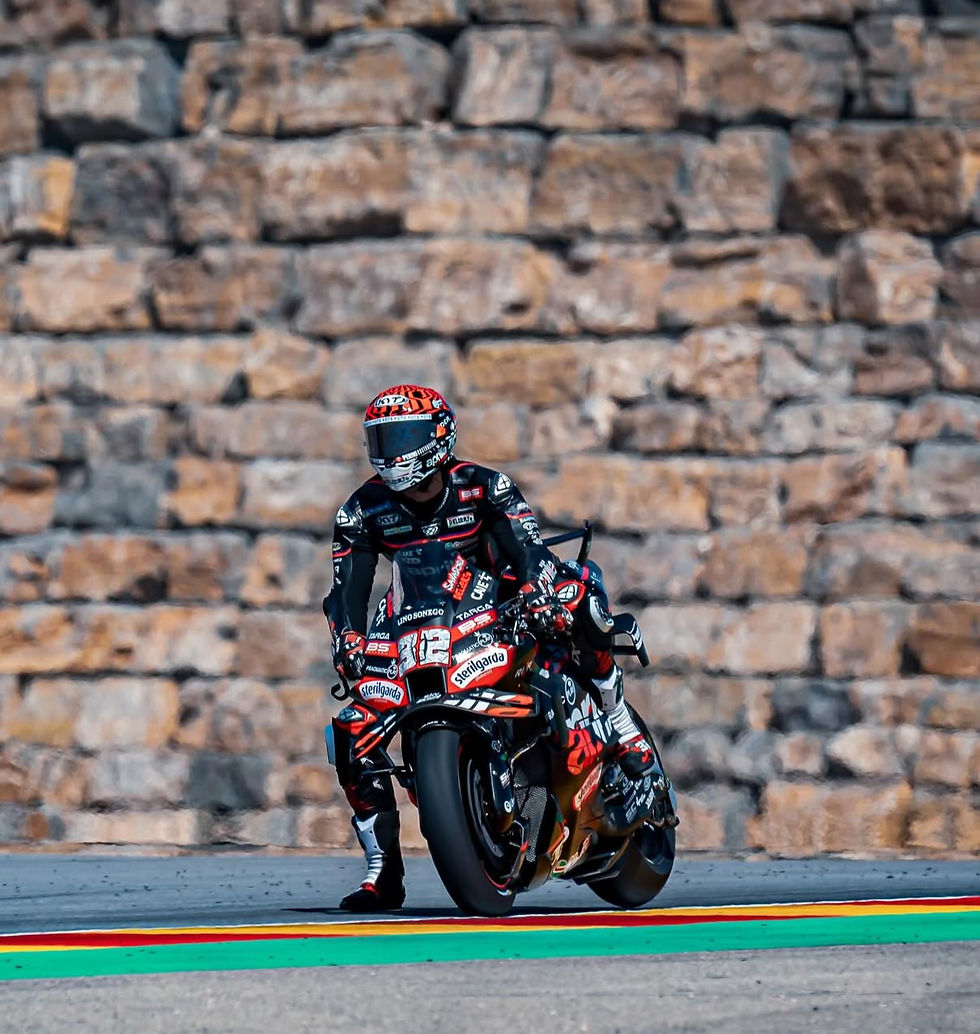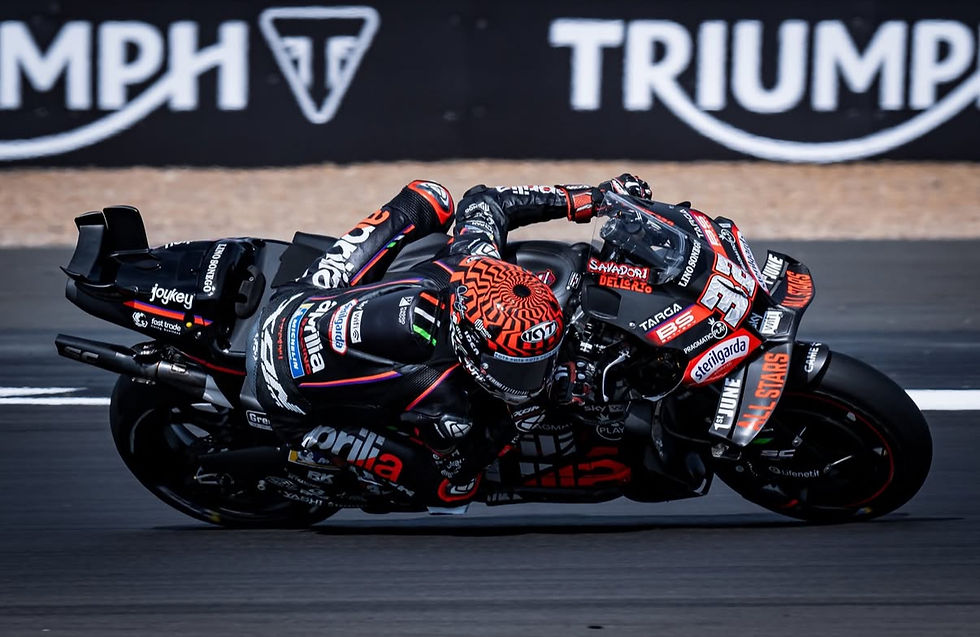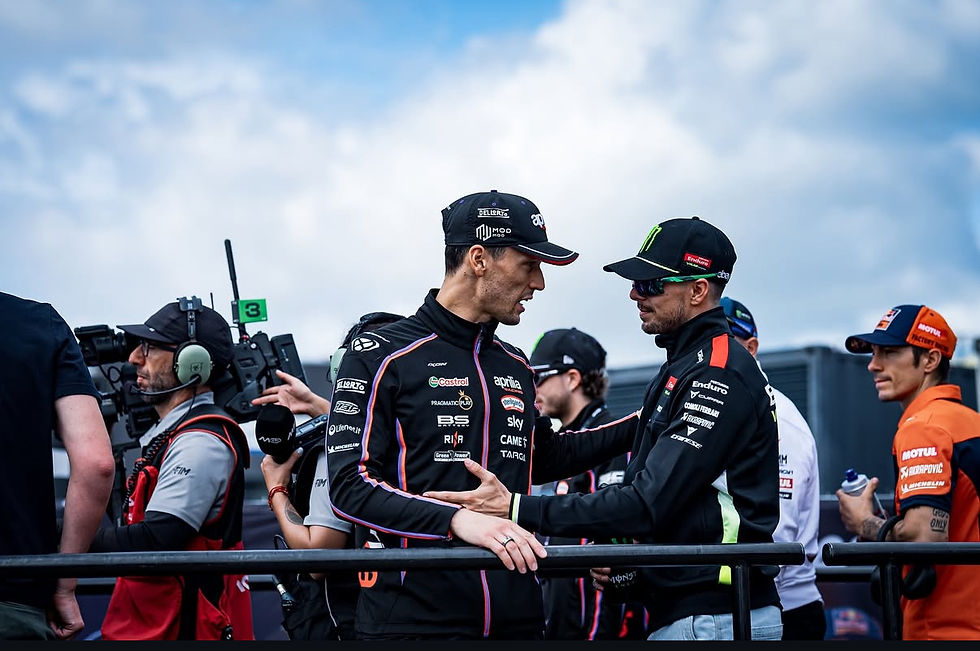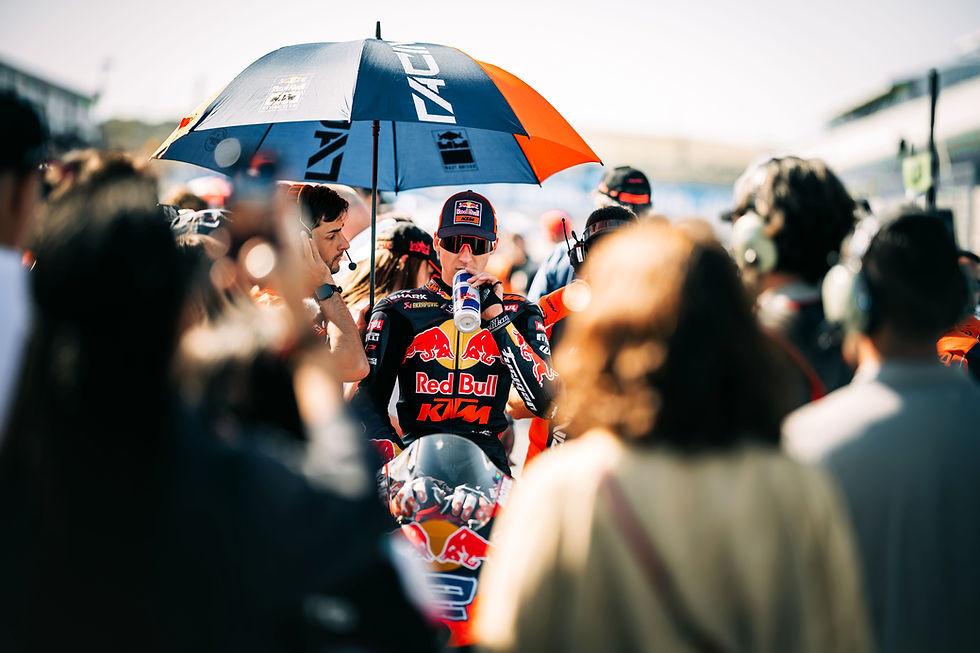Perspectives: MotoGP’s Lorenzo Savadori Reflects on Women’s Progress in Racing
- alicejukes
- Jul 2
- 7 min read
Updated: Jul 28
Lorenzo Savadori has long been Aprilia’s unsung hero. A veteran test rider and former World Superbike competitor with elite experience across MotoGP and WorldSBK, the 32-year-old Italian boasts a 2015 Superstock 1000 Cup title and a 2020 Italian Superbike Championship to his name. These credentials made him an integral part of Aprilia’s MotoGP development program.

Now, in 2025, Savadori is seizing a well-earned moment in the spotlight, stepping up to replace injured reigning world champion Jorge Martin on the Aprilia RS-GP. It is a pinnacle opportunity for a rider who has spent years behind the scenes, and it comes at a time when Aprilia has firmly established itself as one of the sport’s premier forces.
Aprilia’s recent rise has been nothing short of remarkable. Once considered underdogs in the premier class, the Italian manufacturer has evolved into a true MotoGP powerhouse, driven by relentless development and world-class engineering. Riders like Aleix Espargaró and Maverick Viñales have led the charge since the team’s breakthrough 2022 season, delivering race wins and regular podiums.

The RS-GP has continued to prove itself as a winning machine, most recently with Marco Bezzecchi’s stunning victory at Silverstone in 2025. Jorge Martin’s arrival at the start of the season further elevated Aprilia’s status as a destination for elite talent. Now, with Savadori stepping into a full-time factory role, the team’s depth and belief in homegrown experience is on full display.
Amid this exciting chapter in his career, Savadori is also lending his voice to an important cause off the track. In our recent interview, he took time to reflect on the sport’s evolving inclusivity. His and Aprilia’s engagement in the conversation around female representation in motorsport marks a meaningful step forward in the MotoGP paddock’s growing embrace of diversity.
Women in the paddock: A Growing Presence
One of the first changes Savadori has noticed in his years at the Grand Prix level is the surge of female presence among fans and paddock staff. “In the last few years, it’s really nice to see more female fans, more women in the paddock,”Savadori observed. As a rider who frequently meets enthusiasts at events like Aprilia’s fan-centric track days (Aprilia All-Stars Day) and at the MotoGP track every race weekend, he has watched the demographic shift firsthand.
What was once a largely male domain now features increasing numbers of women, from young girls sporting their favorite rider’s gear to women working in team garages. “I think it’s important to have more women [as well as] young people,” he added, noting that the scene “has changed a lot over the years”.

Savadori sees the shift firsthand. From the grandstands to the garages, more women are becoming part of the racing world, not just as fans, but as professionals shaping the sport. For someone who engages with MotoGP supporters across the globe, the change is clear and, to him, refreshing. What was once a male-dominated paddock is slowly becoming more inclusive, and Savadori welcomes that evolution.
World WCR: A New Platform for Female Competitors
Discussing women’s racing inevitably brought up the new all-female World WCR championship. The FIM Women’s Circuit Racing World Championship (WorldWCR) launched in 2024 as the first-ever world championship for women in motorcycle road racing. Run as a support series on the Superbike World Championship tour, it features female racers competing on equal machinery (identical Yamaha R7 bikes) in their own showcase championship.
Savadori has been following its progress. “Yeah, it’s a nice championship. I [have] seen many races,” he said, recalling a particularly exciting event at Italy’s Cremona Circuit where a hard-fought battle culminated in local rider Roberta Ponziani taking the win. Seeing the level of competition, Savadori came away impressed: “It’s nice to have a great battle during the race, so it’s a nice championship,” he smiled.

Beyond simply entertaining, Savadori believes WorldWCR serves a crucial developmental purpose. When asked about women striving to enter mixed-gender championships, he pointed to the performance gap as the biggest hurdle – and to WorldWCR as part of the solution. “The most important things are the level, the competition, the performance,” he explained. “I think the World WCR is a great platform to start to improve the performance of each rider, so… it’s the correct way [forward]”.
In other words, having a dedicated series where female racers can hone their racecraft against top peers is helping raise their game. The inaugural WorldWCR season indeed showcased intense competition (eventual champion Ana Carrasco is a former World Supersport300 title holder), suggesting that more track time and exposure for women riders will elevate their skills to close in on the established benchmarks of mixed championships. Savadori’s endorsement of the series adds weight to that vision.
Success Demands the Same from Everyone
When it comes to entering mixed-gender categories like Moto3, Moto2 or World Supersport, Savadori maintains that the defining factor is not gender but performance. “I think every championship is open,” he said matter-of-factly, downplaying the notion that women are overtly barred from any series. In his view, the racing world is fundamentally a meritocracy: “The most important thing is the performance, the level,” Savadori noted, if a rider is fast enough, opportunities will come. For all competitors, “the target is to improve every time, going up” through the ranks.

His even outlook became more evident when discussing barriers that might be holding women back in the junior ranks. Asked whether issues like physicality or lack of opportunity impede female riders, Savadori resisted singling out any one factor. Instead, he reiterated that success boils down to relentless self-improvement for any rider: “Every rider, female or male, has to be super focused on [their] personal performance,” he emphasized.

To climb the ladder, “you need to work on the details every time… this is the really important thing to keep improving”.Savadori stopped short of citing any inherent barrier differentiating women’s path from men’s, a response that, intentionally or not, frames the challenge in terms of individual development. In his eyes, talent and dedication can trump external obstacles, an encouraging message to aspiring racers from underrepresented groups. It suggests that while women do face unique challenges in motorsport, the key to breaking through is to focus on being the best rider possible, a task equally demanded of every young racer with grand ambitions.
The Physicality Question: “Demanding for Everybody”
Of course, one common talking point in the diversity conversation is the physical demand of handling MotoGP bikes; machines exceeding 160kg in weight, exceeding 350 km/h, and requiring immense strength and stamina to control. Savadori, who has tested and raced the brutally powerful Aprilia RS-GP, acknowledged that modern MotoGP is an extreme physical challenge. “In the last years the MotoGP bikes are really physically demanding, so you need to train a lot,” he said.
With today’s bikes sporting advanced aerodynamic winglets and ground-effect downforce, riders endure heavy g-forces and muscle strain; “with the aerodynamics, [the physical strain is] huge in the last years,” Savadori noted of the added load. Reaching the premier class means meeting those demands: “For arriving in MotoGP, you need to be fast and have a good performance,” he continued, “but it’s demanding for everybody”. In short, every rider, male or female, must put in intense physical training to tame these beasts. If a woman rider aims for MotoGP, he implies, she will face the same gauntlet of fitness as any man; neither more nor less.

Looking ahead, the Aprilia rider was asked about the 2027 regulations that will introduce slightly smaller, lower aero bikes to the premier class. Could that technical shift make it easier for a female racer to reach MotoGP?
Savadori was prudent in his assessment. “Honestly, I don’t know because I’ve never tried the new bike,” he admitted, deferring judgement until he gets a firsthand feel for the upcoming spec. Those 2027 bikes are expected to reduce top speeds and perhaps lighten the physical burden marginally, but Savadori wasn’t about to speculate. “At the moment, the MotoGP bikes are physical for everybody,” he reiterated. If anything, Savadori’s viewpoint suggests that while rule changes may incrementally improve accessibility, the fundamental hurdles of MotoGP, skill, speed, and fitness, will remain high. The playing field may become a touch more level when the machinery is toned down, but it will still come down to individual riders to push their limits.
“Never Stop Dreaming”: Advice to Future Racers
As the interview wrapped up, I asked Savadori to impart some advice to young riders, male or female, who aspire to reach the top. His answer came with the heartfelt conviction of someone who has fought his own way up the ranks. “Never stop dreaming. Work really, really hard. And always try to improve the small details,” Savadori urged. The path to elite racing is arduous, and he knows it takes unwavering passion. He encourages the next generation to do the same. Success doesn’t happen overnight, he reminded, but “day by day, you can reach the top”.

Those words resonate as both encouragement and a challenge. Savadori’s own journey, from European 125cc champion at age 15, to Superstock champion, to the trenches of WorldSBK and testing duty, and now to a MotoGP grid spot, exemplifies the value of perseverance. His message makes clear that talent must be matched with tenacity. It’s a fitting capstone to a conversation about elevating women in motorsport: progress will come “day by day,” through hard work and dedication, just as it has for Savadori and Aprilia. And with allies like Lorenzo Savadori openly supporting that progress, the future for women in racing looks a little brighter and a lot more inclusive.
All images are taken from Lorenzo Savadori's Instagram (@Sava32) and are property of Aprilia and Savadori




Comments